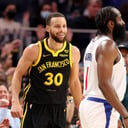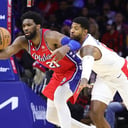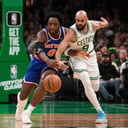When the Philadelphia 76ers sign Paul George later this month, they will have officially pulled off an impressive move.
Since the James Harden-Daryl Morey drama last summer, the Sixers have projected that they would accumulate enough salary cap space to make a splash. was supposed to use that salary space to make a market-shaking trade. Instead, here comes George from Los Angeles, with a four-year, $212 million contract.
George is the first high-profile player to change teams in free agency since 2019. Free agency had become a meeting ground for two types of undesirable partners: mostly uncompetitive teams with limited salary cap space and players not good enough to get big extensions from their own teams. It was like a dating app of last resort. But George and the Sixers have connected in an interesting way, and it’s worth wondering if this is a one-off deal or if the weather vane is pointing in a new direction.
It’s hard to think of many times in recent years when a team has taken a hard-nosed negotiating tactic with a star player, and that’s certainly the case with George, who was an All-Star just a few months ago. The Sixers took a hard line with Harden, but he was already on the decline and didn’t have many suitors once Philadelphia made it clear it would be willing to sell him. The Clippers have imposed limits on George, just as they were able to sign Kawhi Leonard to a three-year, below-the-max deal.
Will this be a harbinger of future austerity in the league? Not for the best players still in their prime, of course, but what about the rest? George is 34, and this next contract will take him until he’s 37. A 37-year-old making more than $56 million is a risky proposition, spring-loaded salary cap projections or not.

GO FURTHER
Hollinger: NBA’s Apron Era Marks End of Exceptionalism + Free Agency Winners and Losers
Every marginal dollar will have a price under the new collective bargaining agreement and its restrictions. Tax rates will increase by 40% for teams that make $20 million more than the luxury tax threshold for the 2025-26 season and by 52.6% for the tax on repeat offenders above that threshold. The collective bargaining agreement was designed to keep teams hovering just around the tax threshold, not far above it, and it will seek to weed out teams that dare to ignore its warnings.
Certainly some teams will use the collective bargaining agreement as a bogeyman for fans and player agents to avoid further spending. That is probably already happening. But there is also real apprehension.
The Clippers cited the CBA three times when the franchise released a statement explaining why it wasn’t re-signing George. The Golden State Warriors have slowly been disarming over the past two summers, tired of being light years away from the tax cut. The Denver Nuggets’ management group has repeatedly mentioned the CBA’s restrictions, though the luxury tax was an annual concern before there was a second deck. The Boston Celtics appear willing to be in the second deck for the next few years after winning the title; plus, Wyc Grousbeck has signaled he’s willing to cash in and sell the team. Certainly, the Phoenix Suns have been an example to others so far, though they’ve also contracted out a significant portion of their draft futures, limiting their ability to make further moves.
Sixers president of basketball operations Daryl Morey, however, has his own way of doing business. He sees no other option than to try to recruit talent and find the rest. This is the third time he’s lured a star from Los Angeles (Dwight Howard and Chris Paul made the jump to Houston). Time will tell whether Sixers ownership is willing to go deep or go to the second deck, but Morey hasn’t been scared off by signing three players to max contracts.
“In those situations, I like the challenge,” Morey said in April after the New York Knicks eliminated the Sixers in the first round of the playoffs. “For me, finding the guys that are overlooked — the Kelly Oubres of the world, getting a Kyle Lowry or players like that — I like that challenge. I think that’s something that management is very good at. And so I think, yeah, compared to — basically, you’re saying less good players, more role players. I think, generally speaking, the history of the NBA would favor — even with the new collective bargaining agreement — (getting) star players that you can then put the work and the responsibility on to find the right players for them.”
The Sixers will be extremely talented. Joel Embiid is one of the best players in the NBA. Tyrese Maxey proved himself last season as a top-tier shooting guard, and his 46-point performance in Game 5 against the Knicks was one of the best of the playoffs. Is George the best teammate Embiid has had in Philadelphia? He fits in easily with him and Maxey. The hardest part will be building a team around that trio. The Sixers have barely enough players on their roster to fill a rotation and about $136 million committed to their three stars in 2024-25.
Will Paul George be the best teammate Joel Embiid has ever had in Philadelphia? pic.twitter.com/38S1zZPinX
– Mike Vorkunov (@MikeVorkunov) July 2, 2024
The Eastern Conference will be brutal next season, a far cry from the golden path the Celtics took to reach the NBA Finals this spring. The Knicks have gained momentum with Mikal Bridges. The Milwaukee Bucks still have Giannis Antetokounmpo and Damian Lillard. The Indiana Pacers are improving. The Miami Heat are the Heat.
But Philadelphia has positioned itself well, even if there are caveats about depth and health. Morey is willing to take risks for a chance at glory. This Sixers team embodies that.

GO FURTHER
Amick: With Paul George’s contract, Sixers are fighting for fences — a move they had to make
Fasten your seat belts in the East
An observation on the Eastern Conference arms race: there hasn’t been one in a long time.
The last time three Eastern Conference teams won 55 or more games was in the 2010-11 season. That was two CBAs and a commissioner ago, and LeBron James had yet to win a ring when that regular season ended. It’s only happened twice since Michael Jordan retired, but next year it’s certainly reasonable for there to be three teams with 55 or more wins between the Celtics, Sixers, Bucks and Knicks.
The Sixers played at a 65-win pace in the 39 games Embiid was healthy last season. The Knicks won 50 games and were 20-3 in games played by OG Anunoby, and they just added Bridges. Milwaukee won a disappointing 49 games in 2023-24, but it still had Antetokounmpo and Lillard and had a plus-10.2 net rating with those two on the court.

GO FURTHER
As Celtics re-sign free agents, Knicks, Sixers pose serious challenge
Changes of ownership
The NBA has changed its rules on team ownership. According to league sources, the league has banned new ownership groups from rotating governors to control teams.
The Bucks had Marc Lasry and Wes Edens rotating as the franchise’s governors when they bought the team. Lasry was governor when he sold his share of the team last year, and Edens took over and will serve through 2028. Rick Schnall and Gabe Plotkin led the group that bought the Charlotte Hornets last summer, and will rotate governors with Schnall currently in charge. Those two franchises, however, have been retained.
CBA makes its mark
When the new collective bargaining agreement was ratified, Commissioner Adam Silver said he was fine with super teams, as long as they were built the right way.
“Smart drafting, smart trades, etc., instead of one team having the opportunity to spend a lot more than another,” Silver said. “I think the new provisions in this collective bargaining agreement will go a long way toward having a positive impact on the league as a whole.”
It’s interesting to see the impact of the NBA’s governing document on a few major teams this offseason. The Clippers are perhaps the biggest offenders of the old spending rules. They racked up big payrolls after signing Leonard in free agency and trading for George and Harden, while also spending on backup players. They just lost George after drawing a line.
The Warriors are the prime example of a team that spends big and drives a wedge between the haves and have-nots. This month, they will lose Klay Thompson, shattering the core of a dynastic team that seemed to have built things right. They drafted Stephen Curry, Draymond Green and Thompson. They signed Kevin Durant in free agency but got a huge salary-cap hit that was out of their control. Now they will have to rebuild on the fly after years of astronomical payrolls. The Celtics could take notes with their own homegrown core, supplemented by outside transfers, who are getting more expensive every year.
The 76ers were the big beneficiaries of this first real offseason of change. Embiid and Maxey were drafted and developed, but Philadelphia signed George in free agency in a manner that seems reminiscent of the player movement of a decade ago, scraping together enough cap space to land a star.
(Top photo of Paul George: Ric Tapia/Icon Sportswire via Getty Images)